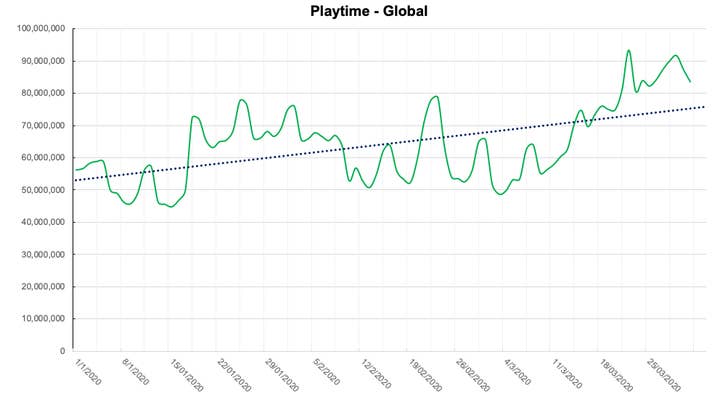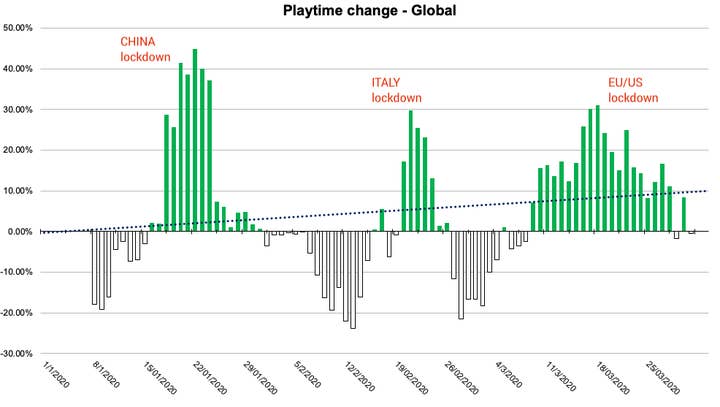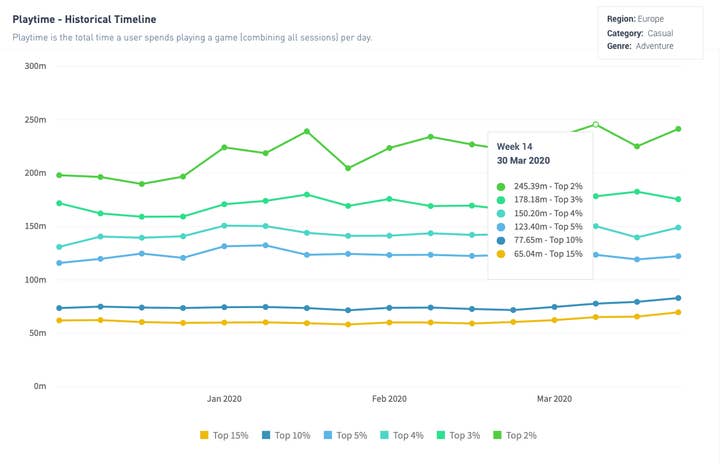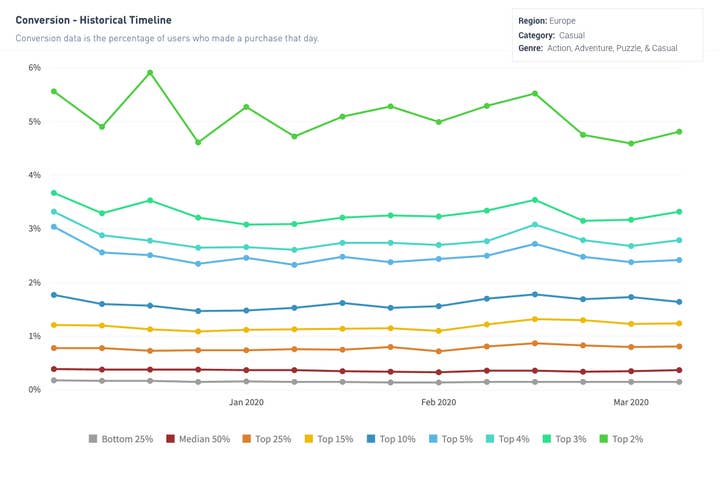Top mobile trends (and some surprises) during COVID-19 lockdown
GameAnalytics CEO Ioana Hreninciuc explores the effect of the pandemic on player behaviour around the world
With millions of us now working from home or with extra time in our hands due to the current lockdown, it's reasonable to expect that we'll be spending more time playing mobile games -- just as we've seen an increase in time spent playing PC and console games.
But with the vast majority of games on mobile built around short, regular bursts of gameplay and a myriad of different uses of gatcha and monetization, shifts in gaming habits can have a big effect on publishers' revenue models.
With this in mind, we took a detailed look at how gameplay times, in-app purchases (IAP) and conversions changed as countries moved into lockdown over the past couple of months. The aim was to find any interesting or unexpected trends that can help developers and publishers better address the challenging business conditions many are going through right now.
Playtime increased by 62% and spend grew by 5% to 30% as countries went into lockdown

Data from the last three months shows that not only people are playing more, but they are also playing for longer. Traffic grew by 46%, from 1.2 billion to 1.75 billion, while global playtime saw a 62% increase from January to the end of March, with peaks of +90 million hours played per day.
With more gamers and more time spent, it might not be a surprise that spending also increased globally, by 5% to 30% per day. Boredom and more time in front of IAP opportunities might be the main reasons behind it, but also the fact that we can't currently spend as much time and money socialising or travelling will obviously play a part.

The announcement of lockdown had the biggest effect on behaviour
Surprisingly, the data shows that changes in player behaviour coincide with when governments announced impending lockdowns because of COVID-19, rather than the actual lockdown implementation.
We looked at where spikes in playtime correlated with the announcement of lockdowns, and the pattern was clear -- a smaller increase as many people start to self-isolate and work from home, then a larger and more sustained increase as official lockdowns come into effect. This is followed by a decline as activity returns closer to the long-term average, but so far we are seeing playtimes and spend remain higher than before.

For example, in the second half of January, we can see there was a huge surge in the amount of time Chinese gamers were spending playing games. This drove global playtimes to rise by 40%, dropping back after a few weeks -- but still remaining 20% higher than pre- lockdown.
To give these numbers some perspective, Tencent's Honor of Kings -- one of the biggest mobile games in China -- struggled to cope with the increased demand as daily users surged past 100 million. Also from Tencent, Game for Peace -- China's localised version of PUBG Mobile -- is another game which saw a big increase in playtime, with the company also having to expand server capacity to cope with an increase in player numbers.

On the 21st of February, we saw a second spike when Italy locked down. This preceded a similar but more sustained spike in the week of March 16 to 20, when most of Europe went into lockdown.
Lots of locked-down players are putting time into adventure games...

While mobile gaming as a whole has seen more players spending more time than ever before, it's not been evenly distributed across different genres of game. We've seen the biggest growth in adventure games as people chose more immersive titles to spend their time with.
Family-friendly games including Scary Teacher 3D, RealmCraft and Idleworld are some of the games in the adventure category that saw a boost in downloads -- as well as perennial kids favourite, Roblox.

The top performing 2% of games in the adventure category saw a 25% increase in playtime to almost four hours (245 min) per player, per day. It's a pretty reasonable assumption that a large proportion of school time has been replaced by screen time.
As well as more time spent playing adventure games, more money was spent on in-app items as well. There was a corresponding 25% increase in ARPDAU (Average Revenue Per Daily Active User) for the top 2% of Adventure games in Europe in March compared to January.
...but casual and mid-core games took a (small) hit
While publishers of the top-performing adventure games were seeing players spend more time than ever enjoying their titles the top 2% of action, puzzle and casual games all saw a 1% drop in players that spent money in those games -- from 5.6% down to 4.6%.
It's hard to know exactly what might have caused this. One reason might simply be that they are spending more time (and money) in adventure games and other titles that are better suited to longer session times. As we can see in the chart showing conversion rates for these games, there has been very little change in spending habits across both the best and worst-performing games. So that suggests it's more about the type of game than any big shifts amongst players of the most popular titles.
Whatever the cause of this slight drop, there does seem to be an uptick in conversions, so it looks like things are returning to the long-term average.

Will the lockdown have a long-term impact on mobile gaming?
It's tempting at the moment to use any data from the past few months as a harbinger of the future. These changes in playtime and spending on mobile may well turn out to be one-off swings -- just as we see seasonal swings in gaming behaviour every year. But it's unlikely that the boost created by millions of new players will be completely lost -- at least in the short term.
A big story in mobile gaming over the past year has been the big rise in hypercasual games, which are often puzzle or simple arcade games designed for snack-sized game sessions. But the data since January has shown more immersive games getting the biggest boost from the increase in playing time. Again, this could be a short term thing, or it could be that players have had their fill of hypercasual games and want something more substantial.
Beyond mobile games, the coronavirus crisis has seen games in the news like never before, with even the World Health Organisation cheerleading for gaming as a way to get through the lockdown. But the industry faces uncertainty as launches are delayed and global marketing showcases like E3 and Gamescom are postponed, even as a new hardware cycle is starting and many companies are depending on consumers spending big to recoup their investment.
Mobile doesn't operate in this kind of linear fashion, so the exposure to risk is very different. But even small changes in player psychology can have an outsized effect on where they end up spending their money in the freemium gaming economy, and developers and publishers need to be quick to jump on any emerging trends.
From our snapshot of the first three months of the year, it seems to be good news. Global playing times remain up from their long term averages, and although some genres of games are doing better than others, we've not seen any major falls in spending or consumption. The question everyone is asking is whether this is the new normal.
Ioana Hreninciuc is CEO of GameAnalytics, which provides tools that enable games developers and publishers to analyse and understand player behaviour in mobile games.
